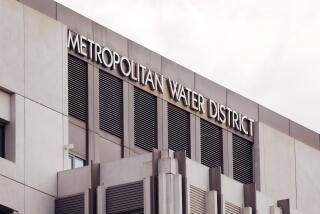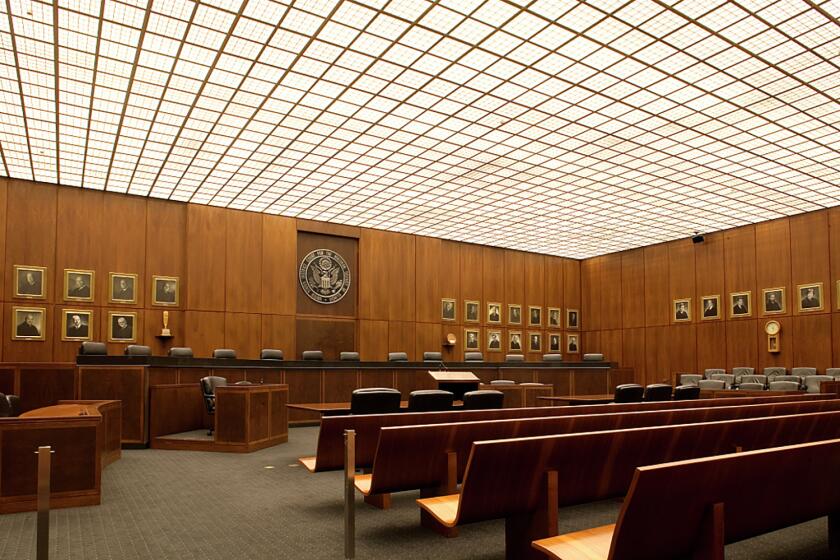The DWP’s little pump that eats money
Just above the Greek Theatre, on the edge of a sloping field adjacent to Vermont Avenue, sits a pump. To the layperson — to this one at any rate — it looks like a big ugly hunk of metal on wheels, one that bears the signs of age and weather. To those who know about such things, this is a 4-inch, high-head, trailer-mounted, diesel centrifugal booster pump, and it serves an important purpose: to boost water pressure and flow for fire protection in Griffith Park.
So, it is noble, this pump, an integral weapon against the potential destruction of the park, including its beloved observatory and the Greek Theatre. But to someone who has walked past it for years on treks through the park, there is also something slightly odd about it: a plaque atop it that reads “Rain for Rent” along with a telephone number in the 805 area code. Could this really be a rented pump? Why would the L.A. Department of Water and Power, the nation’s largest municipally owned utility, rent a pump for years? Surely that could not be economical.
My questions might have remained in the realm of curiosity. But given the city’s budget woes, which have brought us shorter library hours and other cutbacks, it seemed my responsibility, as a loyal L.A. resident and DWP client, to follow up. A few phone calls and a California Public Records Act request for information from the DWP have only increased my skepticism about the arrangement.
The pump was manufactured by Cornell Pump Co. in the Portland, Ore., area, which, according to its website, has been “setting the standard for premium quality, efficient centrifugal pumps since 1946.” When asked by phone about the cost of the thing, a Cornell representative referred me to Bill Scholtes of Premier Pump and Power, which is based in nearby Vancouver, Wash. Scholtes told me that the pump in question, with the diesel engine and trailer mount, would probably cost $35,000 to $40,000 to purchase. Scholtes adds that while it’s difficult to estimate maintenance costs without specifically knowing the type of usage, a general rule of thumb is 15% of the pump’s purchase cost per year.
Rain for Rent, meanwhile, is a pump and water system rental outfit based in Bakersfield, with about 70 locations across the country, including Santa Paula, the office that handles the Griffith Park pump. A Rain for Rent representative referred all questions to the DWP.
According to DWP Director of Water Operations Marty Adams, the pump “was originally necessary to provide a reliable emergency backup water supply for the newly renovated Griffith Observatory.” In order to keep the observatory’s reopening on schedule, he said, the DWP turned to Rain for Rent. “The rental pump was intended to be temporary, pending the replacement of aging water infrastructure — including piping, tanks, and pump stations — in Griffith Park,” Adams explained.
He said the DWP “considered purchasing a permanent pump for the location” but decided to keep renting as the agency continued work on its Griffith Park water system replacement project. Until that was finished, he said, the city wasn’t sure exactly what would be needed.
OK, so the city didn’t want to make a premature investment. But if you do the math, the DWP could have purchased 10 pumps for the rent it has paid to Rain for Rent. According to the utility’s records, the pump was installed in July 2002 — four years before the reopening of the observatory. By October 2010, the DWP had paid a total of roughly $350,000 to Rain for Rent — for a pump that sells for $40,000 or less. The figure is approximate because the files for the first two years of the contract are archived. In addition, there are some odd discrepancies. Records show about $50,000 in rent for the pump in 2004 but only $15,000 in 2005. For each of the next two years, the rent jumps back up to $50,000.
But one thing is certain any way you look at it: The DWP has paid out far more money than it would have if it had simply purchased the pump it needed.
Why didn’t the agency do so? “At the time we entered the rental agreement, we had elected not to make a large capital investment in a new pump station,” Adams says. “Renting the pump allowed us the time to more fully evaluate the need for a permanent facility, consider possible location options and evaluate the hydraulic capability of the rented equipment.”
Adams says that the DWP has now “determined the pump provides sufficient benefits that … we are moving ahead in the next few months, hopefully within this fiscal year, to purchase the existing or another pump unit for long-term use at the current site.” He did not say whether this decision was prompted by my inquiries.
Regardless, I have a couple of more questions. Shouldn’t the city press Rain for Rent, which has already taken in about $350,000 in rent on a $35,000 pump, to simply give the pump to the DWP? And shouldn’t the DWP hire an independent auditor to take a serious look at the other 47 deals it has with Rain for Rent?
The moral of this story? Perhaps simply that a curious citizen, with only a cellphone, a pen and a few simple questions, can unearth some pretty interesting stories in Los Angeles — and just possibly help to keep the city honest in the process. All it takes is an observant eye — and the ability to say “no” to that little character on your shoulder whispering, “Forget it, Jake. It’s Griffith Park.”
Tom Christie is a Los Angeles writer and editor.
More to Read
A cure for the common opinion
Get thought-provoking perspectives with our weekly newsletter.
You may occasionally receive promotional content from the Los Angeles Times.






